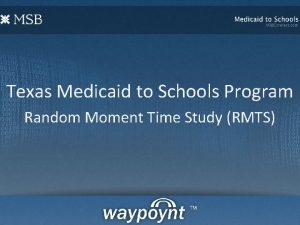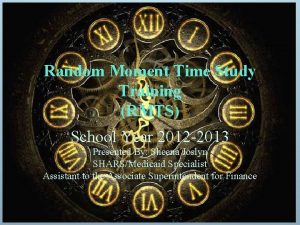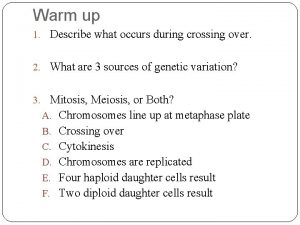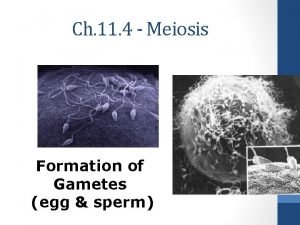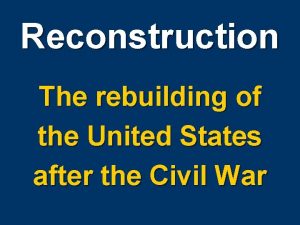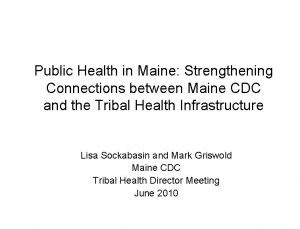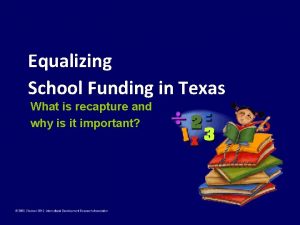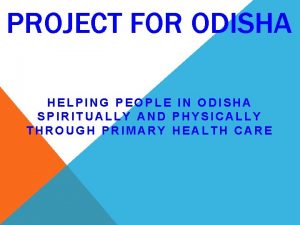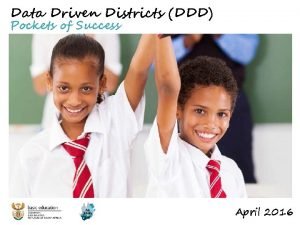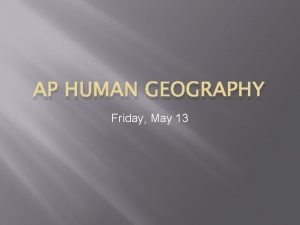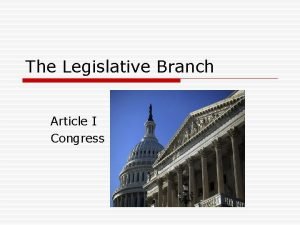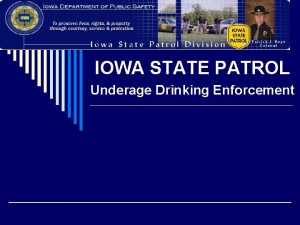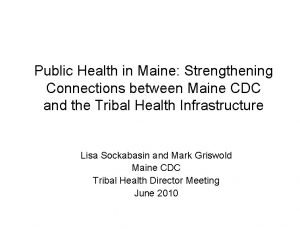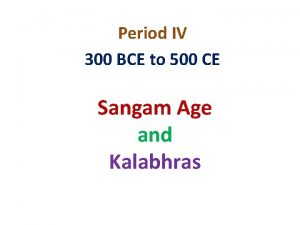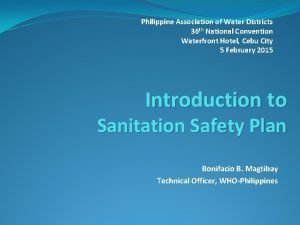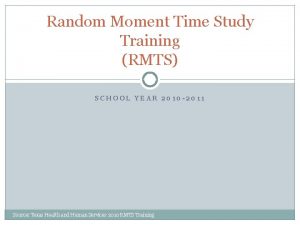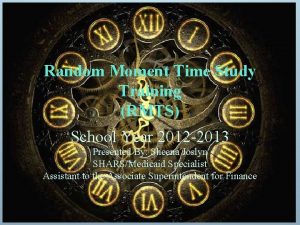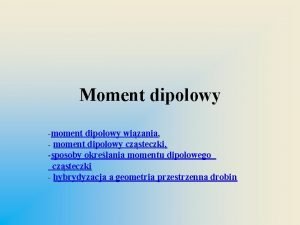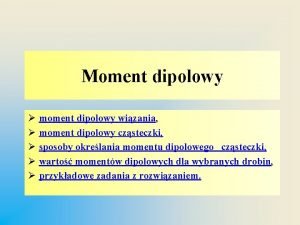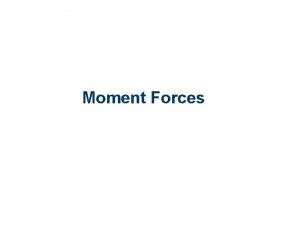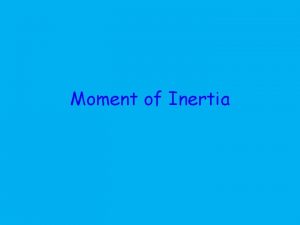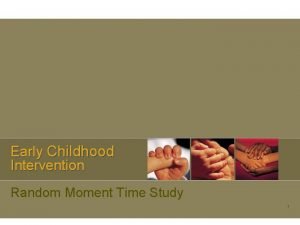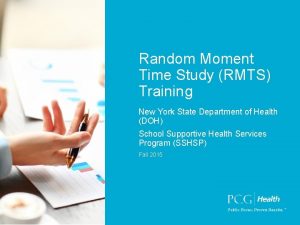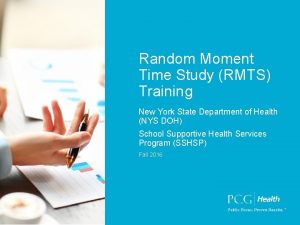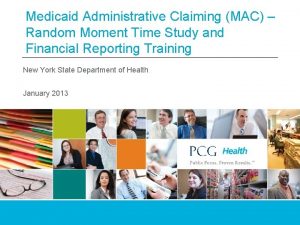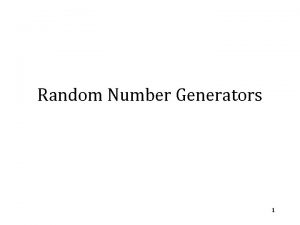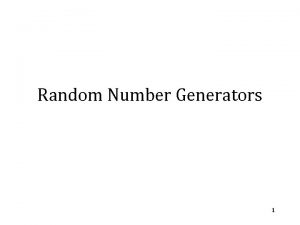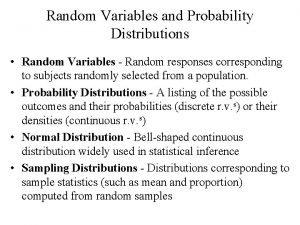Random Moment Time Study Independent School Districts 1


























- Slides: 26

Random Moment Time Study Independent School Districts 1

Overview – What is Random Moment Time Study (RMTS)? � A federally accepted statistically valid random sampling technique that measures the participant’s time performing work activities � A RMTS “Moment” represents one minute of time that is randomly selected from all available moments within the time study period � Statewide time study sample � Significantly reduces staff time needed to record participant activities 2

Requirements for RMTS � Time Study Periods (Federal Fiscal Quarters) � 1 st Quarter - October, November, December � 2 nd Quarter - January, February, March � 3 rd Quarter - April, May, June � 4 th Quarter – No Time Study conducted � A statewide response rate of 85% for RMTS moments is required. 3

�Time Study Participant • Must answer the following to document the sampled moment: • Who was with you? • What were you doing? • Why were you performing activity? • Must attend annual training provided by trained RMTS Contact • Participant notified of moment 3 days in advance • Enter response within 5 business days of moment • Reminders sent to participants via e-mail at 24, 48, & 72 hrs • Primary RMTS Contact copied on the 72 hour reminder • Failure to enter the information will disqualify the moment • Respond to follow-up questions from coders within 3 calendar days from receipt of e-mail. • Primary RMTS Contact will be copied on the e-mail 4

Moment – Notification Example E-mail sent to selected participants 5

Moment - Welcome Screen www. fairbanksllc. com 6

Moment - Login Screen 7

Moment – Start RMTS 8

Moment – Instruction Screen 9

Moment - Responses WHO Was With You? WHAT Were You Doing? WHY Were You Doing It? 10

Moment – System Demonstration �Demonstration of RMTS online system • Sampled Participant’s Response to Moment 11

Response – PCSP Question 1: Who was with you? 12

Response – Non-PCSP Question 1: Who was with you? 13

Response – Question 1 (Non-PCSP) Example Question 1: Who was with you? • Student, Special Ed (Age 0 -2) (Age 3 -20) (Age >21) • Student, Special Ed, Lifeskills (Age 0 -2) (Age 3 -20) (Age >21) • Student, Not Special Ed • Student (Multiple) • No one alone • District staff – Administrator Teacher School nurse SHARS Service Provider Non SHARS Service Provider Indicates additional • • On the phone with parent Community Contact Staff meeting Staffing No student/family present Student and/or family present Student's family Non special Ed students Special Ed student Student AND Family Non special Ed students Special Ed student Not Working Paid time off Non Paid time off Other – please specify below question based on previous response 14

Response Question 2: What were you doing? 15

Response Question 2: Example What were you doing? (Text Box) Typically 2 -4 sentences that provides specific information about what you were doing at that minute. Please keep in mind that the person coding the moment has no idea of the participant’s job description; tasks performed or why they are performed. It is up to the participant to provide the information needed for those independent coders to code the response accurately. Please don’t use acronyms in the description. Please don’t use people’s names in the responses. If not working, indicate if it was paid or unpaid time off. 16

Response – Non-PCSP Question 3: Why were you performing this activity? 17

Response – Question 3 Example Question 3: Why were you performing this activity? • • • To provide a direct medical service as defined on a student’s IEP To provide a direct medical service NOT defined on a student’s IEP To provide a educational service as defined on a student’s IEP To provide a educational service NOT defined on a student’s IEP To determine a student’s eligibility for services: SHARS (School Health and Related Service) All Other Services • To improve health services for the district’s students • To provide or obtain information to or from a student’s family Regarding SHARS (School Health and Related Service) Regarding all other service Regarding an evaluation/assessment for SHARS Regarding an evaluation/assessment for all other services • To assist student/family in applying for health benefits 18

Response – Question 3 Example Question 3: Why were you performing this activity? • • To assist student/family in applying for all other services To upgrade professional skills through training Through medical/health related training Through educational training • • To improve social/vocational/educational services for the district’s students To coordinate transportation To a SHARS (School Health and Related Service) To all other services • To coordinate translation For a SHARS (School Health and Related Service) For all other services • To provide translation For a SHARS service For all other services • To provide guidance counseling 19

Response – Question 3 Example Question 3: Why were you performing this activity? • • To provide direct supervision of a students and student events To participate in an IEP meeting Educational discussion School health-related discussion • Other – please specify below 20

Response –PCSP Question 4: Why were you performing this activity? (Auto-populates based on answer to Q 1) 21

Complete Time Study Review and Submit (Print) 22

Complete Time Study Review and Submit (Confirmation Receipt) 23

Educational or Direct Medical? Direct Medical Services Include: • Medical services that require a licensed, skilled, trained professional • • • Nursing Psychology Counseling OT, PT, Speech, Evaluations • Personal Care Services Activities that require human intervention to accomplish the task the student would normally do for themselves if they did not have a disability or chronic medical condition, i. e. hands on assistance, monitoring, cueing, Activities of Daily Living (ADL) 24

Educational or Direct Medical? � Educational Services Include: • • Reading/English/Language Arts Writing Mathematics Science Social studies Physical education Electives • Activities that do not require human intervention to accomplish the task the student would normally do for themselves if they did not have a disability or chronic medical condition 25

Personal Care Services � Personal care services (PCS) are provided to assist a student with a disability or chronic health condition so they may benefit from educational services � Personal care services include a range of human assistance provided to students to accomplish tasks the student would normally do for themselves if they did not have a disability A student may be physically capable of eating lunch but is unable to independently eat in the cafeteria because of functional, cognitive, or behavioral impairments � PCS may be provided by a wide range of school personnel Teacher Aides Health Care Aides Instructional Aides Bilingual Aides Bus Aides/Monitors Orientation/Mobility Specialists Teachers Clerks 26
 Random moment time study texas
Random moment time study texas Random moment time study texas
Random moment time study texas Colorado springs school districts
Colorado springs school districts Random assignment vs random sampling
Random assignment vs random sampling Random assignment vs random selection
Random assignment vs random selection Moment of random variable
Moment of random variable What is reproduction and its types
What is reproduction and its types Gamete vs somatic cell
Gamete vs somatic cell Texas public school finance overview
Texas public school finance overview Texas recapture districts
Texas recapture districts Carpetbaggers cartoon
Carpetbaggers cartoon Maine public health districts
Maine public health districts Texas recapture districts
Texas recapture districts East odisha districts
East odisha districts Define delimit demarcate administrate
Define delimit demarcate administrate Zoning districts
Zoning districts Maharashtra districts in 1960
Maharashtra districts in 1960 Ddd education
Ddd education Voting districts definition ap human geography
Voting districts definition ap human geography Arizona congressional districts
Arizona congressional districts Iowa state patrol districts
Iowa state patrol districts Russia federal districts
Russia federal districts What is haymitch's training strategy for katniss and peeta
What is haymitch's training strategy for katniss and peeta Maine public health districts
Maine public health districts What are the districts in paris called
What are the districts in paris called Chera nadu districts
Chera nadu districts Philippine association of water districts
Philippine association of water districts
